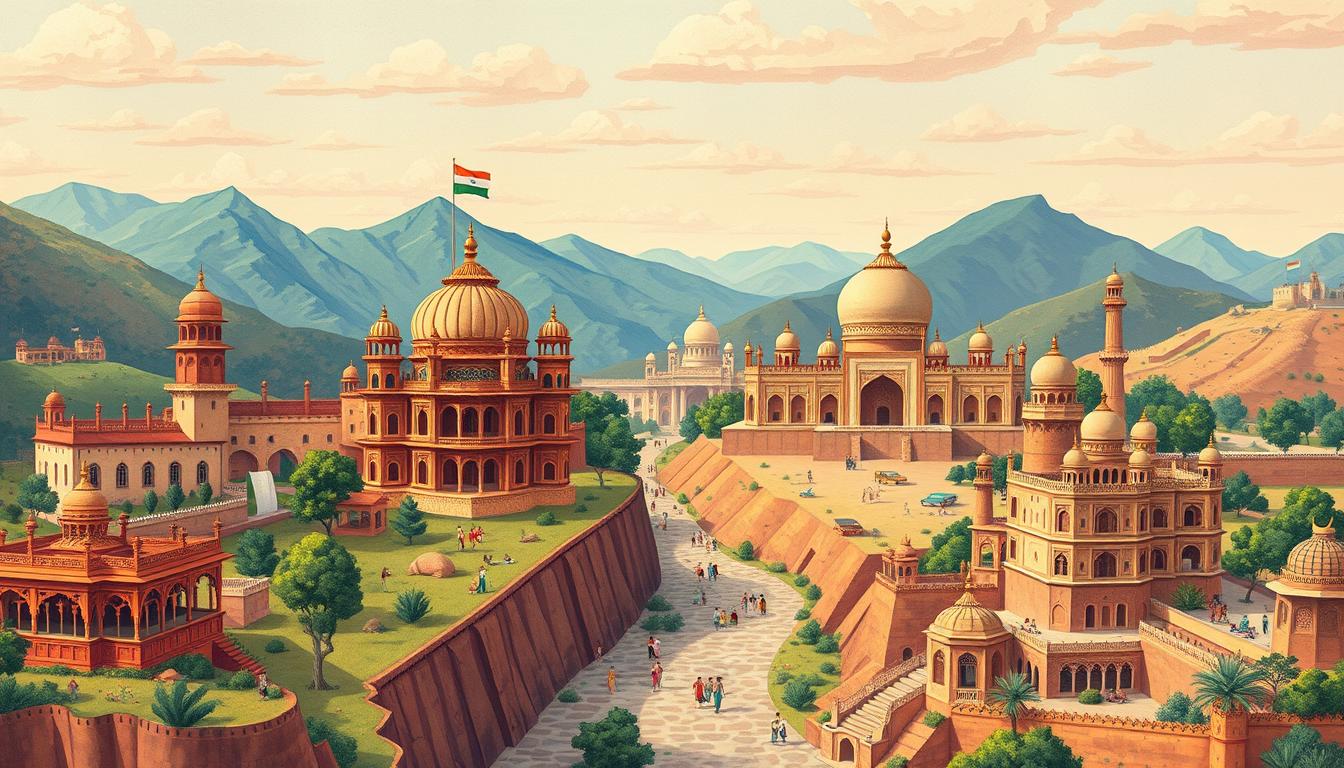Pakistan-India Relations have constantly evolved. The bond between Pakistan and India is complex. It’s shaped by a history of partition, territorial disputes, and ongoing tensions. The split of British India in 1947 created these two nations. This event set the stage for long-standing conflicts based on religious and ethnic differences.
The Kashmir region has been a major point of contention. Wars and an unresolved status have kept tensions high. Both countries have also been in a nuclear arms race, making things even more complicated.
Issues like cross-border terrorism, water disputes, and trade challenges have added to the strain. Yet, cultural connections and people-to-people ties offer hope for cooperation. The influence of major powers, like the United States and China, also plays a role in shaping their relationship.
Key Takeaways
- The partition of British India in 1947 led to the creation of Pakistan and India, setting the stage for long-standing conflicts.
- The Kashmir region has been a perpetual flashpoint, with wars and unresolved status fueling bilateral tensions.
- Both countries have engaged in a nuclear arms race, further complicating the geopolitical landscape.
- Cross-border terrorism, water disputes, and trade challenges have strained the relationship between Pakistan and India.
- Cultural connections and people-to-people ties provide a foundation for potential cooperation between the two countries.
The Partition of British India
The partition of British India in 1947 was a key moment in history. It led to the birth of India and Pakistan as independent nations. This decision was driven by the desire for self-rule and growing religious and ethnic tensions, especially between Hindus and Muslims.
The Seeds of Conflict
The partition process was filled with violence and the displacement of millions. The division of Punjab and the Kashmir issue added to the tensions. These factors set the stage for future conflicts between India and Pakistan.
Religious and Ethnic Tensions
The partition of British India was fueled by long-standing religious and ethnic tensions. The independence movement was gaining strength, with different groups fighting for their rights. This led to communal violence and the partition of Punjab, widening the gap between Hindus and Muslims.
“The partition of British India was a complex and contentious affair, marred by widespread communal violence and the displacement of millions of people.”
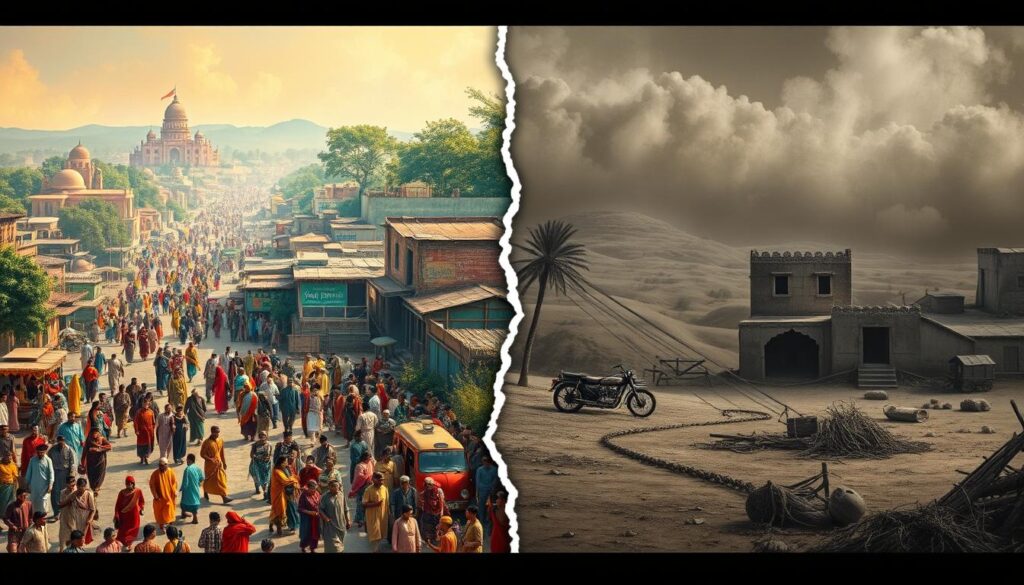
- The partition of British India was influenced by the growing demands for self-governance and the rise of religious and ethnic tensions.
- The partition process was marred by communal violence and the displacement of millions of people.
- The division of the former province of Punjab and the uncertainty over the status of Kashmir further exacerbated the tensions.
- The independence movement had gained momentum, with various political factions vying for control and the right to self-determination.
- The partition of British India laid the seeds for ongoing conflicts between India and Pakistan.
Kashmir: The Perpetual Flashpoint
The Kashmir conflict is a big issue between Pakistan and India. Both countries want to control the important territory. The first Indo-Pakistan war in 1947-48 led to a ceasefire line, now called the Line of Control. This line splits Kashmir between the two nations.
Later, wars in 1965 and 1999 made things even more complicated. Neither side is ready to give up its claim to Kashmir.
The unresolved status of Kashmir makes things tense between the two countries. It could lead to bigger problems. The dispute has caused many military battles and diplomatic problems over time.
Territorial Dispute and War in 1947-48
The Kashmir conflict started when British India was divided in 1947. This created India and Pakistan. The state of Jammu and Kashmir, mostly Muslim, had to choose between them. It chose India, causing the first Indo-Pakistan war in 1947-48.
Subsequent Conflicts and Unresolved Status
The war ended with a ceasefire line, now the Line of Control. But the territorial dispute didn’t go away. It led to more conflicts, like the wars in 1965 and 1999. Many talks have tried to solve it, but Kashmir’s status is still a big problem.
“The Kashmir issue has been a thorn in the side of India-Pakistan relations, fueling tensions and instability in the region for decades.”
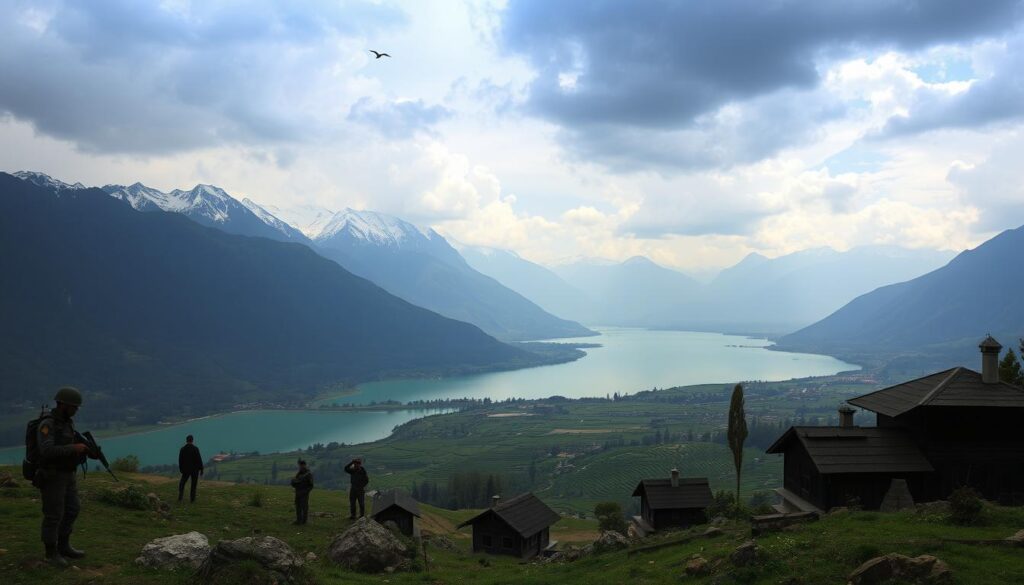
Pakistan-India Relations
Despite long-standing tensions, Pakistan and India have worked to improve their relationship. They have used diplomatic efforts to reduce tensions and find common ground. This has helped in fostering dialogue and exploring cooperation opportunities.
Diplomatic Efforts and Confidence-Building Measures
Both countries have held summit meetings and engaged in backchannel talks. They have also set up ceasefire agreements along the Line of Control. These steps have helped in opening communication channels and addressing concerns.
The Lahore Declaration of 1999 is a key example. It was signed by the then-Prime Ministers of Pakistan and India. The declaration aimed to improve cooperation and resolve the Kashmir dispute through dialogue.
“The two countries will take immediate steps for reducing the risk of accidental or unauthorized use of nuclear weapons and discuss concepts and doctrines with a view to elaborating measures for confidence building in the nuclear and conventional fields, aimed at prevention of conflict.”1
However, progress in Pakistan-India relations has been mixed. The relationship has seen both cooperation and renewed tensions. Issues like the Kashmir dispute and cross-border terrorism have hindered progress.
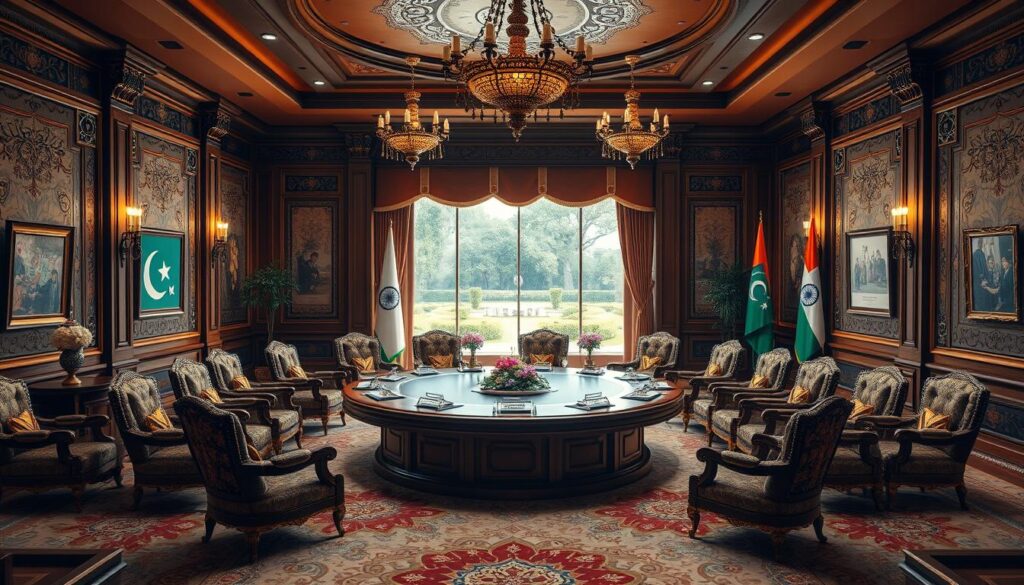
Despite challenges, there is still a chance for more diplomatic efforts. Both countries see the value in addressing their differences. They aim to achieve regional peace and stability.
1. Lahore Declaration, 1999. “The Lahore Declaration.” Ministry of External Affairs, Government of India, 21 Feb. 1999, https://mea.gov.in/bilateral-documents.htm?dtl/6639/Lahore+Declaration.
The Nuclear Rivalry
The Pakistan and India both have nuclear weapons now. This has made their relationship more complicated. They are in a nuclear arms race, trying to keep up with each other.
This pakistan-india nuclear rivalry makes any fight more dangerous. The chance of a nuclear confrontation is always there.
Pakistan and India have tested ballistic missiles and improved their delivery systems. This has made the nuclear deterrence stronger. They keep trying to make their nuclear weapons more powerful.
“The pakistan-india nuclear rivalry has become a major source of tension in the region, with both countries investing heavily in their nuclear capabilities and engaging in a continuous arms race.”
The nuclear rivalry between Pakistan and India affects more than just them. It worries the whole region and the world. We need good ways to stop conflicts and keep everyone safe.
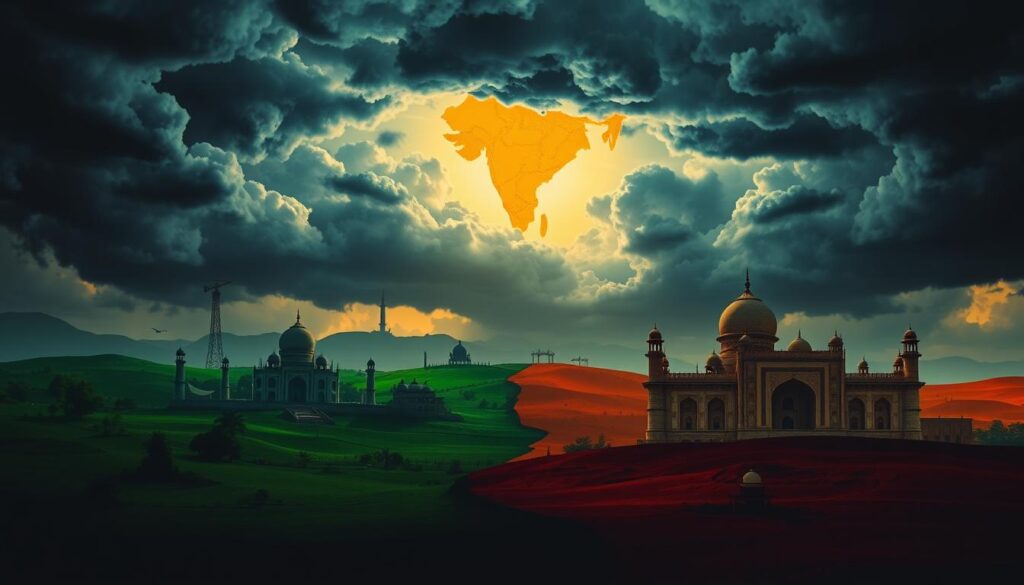
Cross-Border Terrorism and Security Concerns
The rivalry between Pakistan and India has been ongoing for years. A big issue is cross-border terrorism. Both sides blame each other for supporting terrorist groups that attack across the border. This has led to a lot of mistrust and more security measures.
Allegations and Counterallegations
India says Pakistan-based groups like Lashkar-e-Taiba and Jaish-e-Mohammed have attacked India. They point to the 2008 Mumbai attacks and the 2016 Uri attack. Pakistan denies these claims and says India is trying to destabilize it.
Impact on Bilateral Ties
- The back-and-forth accusations have led to more border clashes and military buildups. This has made the relationship between the two countries even worse.
- The security worries have also hurt diplomatic talks. This has limited economic cooperation and kept the trust between Pakistan and India low.
- The ongoing tensions have affected people living near the border. They have seen the effects of border clashes and military actions.
The issue of cross-border terrorism is a big obstacle to better relations between Pakistan and India. It shows the need for a deep and ongoing dialogue to tackle the security concerns of both sides.
“The threat of cross-border terrorism has become a formidable challenge, undermining efforts to build trust and foster cooperation between Pakistan and India.”
Water Disputes and the Indus Waters Treaty
The sharing of rivers like the Indus has caused tension between Pakistan and India. The Indus Waters Treaty from 1960 tries to divide the water fairly. But, both sides often say the other is not following the rules.
Water scarcity makes things worse. Both countries want a fair share of the limited water. This has led to more conflict over how to use the rivers.
Sharing of Transboundary Rivers
The Indus River system is vital for both countries. It starts in Tibet and goes through India and Pakistan. The treaty aims to share the water wisely, but disagreements have popped up.
- Pakistan says India takes too much water from the eastern rivers.
- India claims it’s using the water as agreed upon.
- The water disputes have strained relations and could lead to more conflict.
“The Indus Waters Treaty has been a source of both cooperation and contention between Pakistan and India. Resolving the issues surrounding the treaty is crucial for maintaining regional stability and addressing the growing concerns over water scarcity.
As water demand grows, finding a fair solution is urgent. The Indus Waters Treaty and how we manage rivers are key to the Pakistan-India relationship.
Trade and Economic Ties
Despite long-standing political and security issues, Pakistan and India have a big chance to boost their trade and economic ties. The current trade is limited by high tariffs, logistics problems, and poor connectivity. But, by fixing these issues, both countries can gain many economic benefits.
Potential for Increased Cooperation
Experts believe that growing bilateral trade, making it easier for cross-border investment, and exploring regional integration can help. By tackling the trade imbalance and finding investment opportunities in different sectors, they can create win-win economic ties.
- Eliminate tariff barriers and enhance trade facilitation measures
- Improve cross-border connectivity and logistics to enhance market access
- Promote regional integration initiatives such as the South Asian Association for Regional Cooperation (SAARC)
- Encourage cross-border investment and the exploration of complementary industries
By focusing on these areas, Pakistan and India can reach the full potential of their economic cooperation. This will help improve their overall relationship.
“Strengthening trade and economic ties between Pakistan and India can have a positive impact on the region’s prosperity and stability.”
Cultural Connections and People-to-People Ties
Despite challenges, Pakistan and India share deep cultural ties. They have a rich heritage of people-to-people exchanges. From art to sports, these connections offer a chance to improve relations.
The cultural heritage of Pakistan and India shows their shared history. It highlights the exchange of ideas and artistic expressions over centuries. Poets like Allama Iqbal and Rabindranath Tagore, and dance forms like Kathak and Bharatanatyam, have inspired both nations.
In sports and entertainment, cricket, Bollywood, and music unite people. Cultural exchanges and collaborations can foster understanding. They lay the groundwork for better relations between the two countries.
“The cultural ties that bind Pakistan and India are deeper than the political tensions that divide them. By nurturing these connections, we can pave the way for a future of greater cooperation and shared prosperity.”
The cultural bonds between Pakistan and India offer hope for peace. By embracing their shared heritage, they can use cultural diplomacy to transform their relationship.
- The two countries share a rich tradition of arts and literature, including the works of iconic poets and authors.
- Pakistan and India have a mutual passion for sports and entertainment, particularly cricket and Bollywood films.
- Initiatives that promote cultural exchanges and people-to-people interactions can help build bridges and foster mutual understanding.
The Role of Major Powers
The ties between Pakistan, India, the United States, and China have greatly influenced the region. The US has been closer to India, while its relationship with Pakistan has seen ups and downs. On the other hand, China has grown closer to Pakistan, offering economic and diplomatic help.
Influence of the United States and China
The complex relationships between these major powers have made things harder for Pakistan and India. Both countries are trying to use these connections to get ahead. How well they manage these relationships will be key to peace and stability in the region.
- The US has strong ties with India, but its relationship with Pakistan has seen both good and bad times.
- China has become a big supporter of Pakistan, offering economic and diplomatic aid, which affects the region’s politics.
- The changing alliances and the influence of the US and China have made things even more complicated for Pakistan and India. Both are trying to use these relationships to their benefit.
“The interplay of major power dynamics has further complicated the Pakistan-India equation, with each country seeking to leverage these relationships to advance its strategic interests.”
Understanding the complex us-pakistan relations, us-india relations, china-pakistan relations, and china-india relations is vital. It will help Pakistan and India shape the regional geopolitics and work towards lasting peace.
Prospects for Lasting Peace and Normalization
The journey to lasting peace and normalizing relations between Pakistan and India is tough. It faces big challenges and bright opportunities. The long-standing territorial disputes, security concerns, and trust issues are major hurdles to a lasting peace.
Challenges and Opportunities
The unresolved Kashmir issue is a big challenge. It has been a major point of contention for years. Finding a solution will need political will, diplomacy, and a commitment to finding common ground.
Security concerns from cross-border terrorism also strain relations. But, there are chances for progress. Increased economic integration could be a strong driver for normalization of relations. Cultural exchanges and people-to-people ties can also help build bridges towards lasting peace.
“Lasting peace between Pakistan and India can only be achieved through a comprehensive, mutually beneficial, and sustainable solution that addresses the core issues driving the conflict.”
It’s important for both countries to look for new ways and build trust. They must focus on the region’s long-term stability and prosperity. By tackling the challenges and grabbing the opportunities, Pakistan and India can work towards a future of lasting peace and economic integration.
The Road Ahead: Diplomacy and Conflict Resolution
Fixing the long-standing issues between Pakistan and India needs a mix of diplomacy and ways to solve conflicts. It’s important to boost diplomatic efforts and build trust. The world community’s help, through mediation, could be key in finding peace.
Working together on projects like trade and the environment is also vital. This can help both countries trust each other more. By focusing on shared goals, they can move away from constant competition.
The journey to better relations is tough, but the rewards are huge. Better ties could lead to more economic growth and cultural exchange. Sticking to diplomacy and teamwork is crucial for a brighter future.
- The Partition of British India
- Kashmir: The Perpetual Flashpoint
- Pakistan-India Relations
- The Nuclear Rivalry
- Cross-Border Terrorism and Security Concerns
- Water Disputes and the Indus Waters Treaty
- Trade and Economic Ties
- Cultural Connections and People-to-People Ties
- The Role of Major Powers
- Prospects for Lasting Peace and Normalization
- The Road Ahead: Diplomacy and Conflict Resolution
